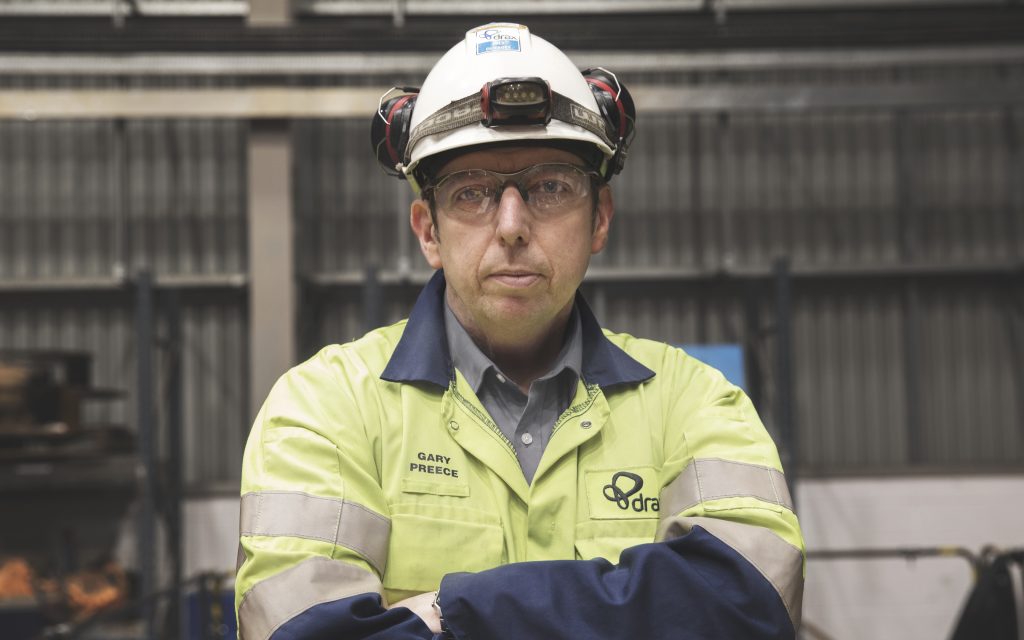A station like Drax doesn’t run itself. Its six turbines generate nearly 4,000MW of power when operating at full load. Unsurprisingly, for a site that produces 7% of Britain’s electricity needs, the role of an electrical engineer is an important one – both when managing how power is connected to the high-voltage electricity transmission grid, and how the giant electrical machines generating the energy work.
“It doesn’t get much bigger than Drax. You need to be at the top of your game, every day,” says Lead Engineer Gary Preece.
A man at the top of his game is a fair way to describe Preece. He has been an electrical engineer almost his entire life. Beginning as an apprentice working at the Liverpool dockyards at age 16, Preece has worked a range of increasingly demanding projects and roles, including engineering consultancy and work for the Royal Navy on their Type 26 Global Combat Ship, where he was in charge of designing the on-board power infrastructure.
He became a member of the Drax team five years ago.
Life on the job
“On a station the size of Drax, you don’t have a typical day. There are just too many systems that can change status, that can fail, or that require immediate attention to remain operational. It’s never-ending,” Preece says.
Working as an electrical engineer in a plant the size of Drax doesn’t just mean getting called down to help out when a fuse blows. His responsibilities as lead engineer encompass a broad range of functions.
“There’s lots to do. There’s a lot of hands-on work, but there’s also a lot of study work.” Tasks can include scoping out, planning and budgeting new projects, working with contractors and suppliers, fault analysis and power level studies.
This last role is what Preece has come to like most about the job – working with sophisticated computer simulations to model output and crisis scenarios, all so Drax can operate at its optimal level with National Grid.
“I really enjoy a lot of the theoretical work,” he says. “We can do so much with this software.”
Of course, there are times when he does have to fix things. And in a power plant, mistakes can have major consequences. “The energy levels in a power plant are so high that when something fails, it usually fails spectacularly.”
This means Preece needs to be on call all day and all night. If there’s a technology failure, he needs to be on the site, finding out what went wrong and directing recovery efforts. “There’s no hiding place. If something goes wrong, you have to fix it.”
Transforming Drax’s electric infrastructure
Sometimes individual projects can occupy all aspects of Preece: engineer, thinker and planner.
One of the most challenging was when Drax wanted to import a largely unused industrial generator transformer unit from Kent to the station in Yorkshire.
The transformer was split into three 200-tonne components. Before transit, Preece and his team conducted extensive checks on the components and oil (transformers contain oil to insulate the coil), to evaluate the state of the machinery. And these steps had to be repeated after every stage of the journey, to ensure no damage had been sustained.
After checks were completed, the units needed to be transported via the M25 motorway to ports in the south of England, from which they would travel by ship on the North Sea, ready to be unloaded and transported to Drax for installation.
However, the team hit complications, this time with the Highways Agency. “The structures were so heavy, that we had to take a ferry from a different port because authorities were worried the bridges we were planning on using to get there wouldn’t take the weight of the units. We had to do a turnaround in the middle of the motorway!”
Getting the extra transformers installed gave the plant some important breathing room in the unlikely event of a failure. “Some power stations don’t have spares. If there was a failure, they could be out of commission for months,” says Preece.
For a power station as large as Drax, that would be disastrous. But even with the extra transformers on site, the number of ways the electrical infrastructure at a power plant can go wrong is huge. That’s why experienced engineers like Preece are as indispensable as the machinery itself.
“Drax is one of the best opportunities you’re going to get for artistic licence. It doesn’t get much bigger.”












